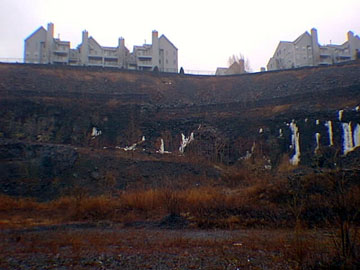40. The Paterson/Great Falls Area
The potential power of the Great Falls of the Passaic River so inspired Alexander Hamilton that he organized the Society for Establishing Useful Manufactures and planned America's first industrial city (Figure 91). Pierre L'Enfant, the planner of Washington, D.C., designed a complex three-tired system that harnessed the falls and supplied water power to several industrial mills. The city of Paterson became a thriving industrial center known for the manufacture of silk and locomotive parts. Today, the old industrial complete has been partially restored.
 |
| Figure 91. Great Falls of the Passaic River in Paterson, New Jersey. |
To get to the falls, take I-80 west to the Paterson exit (Exit 57). Turn left onto Grand Street for 0.3 miles, turn right onto Spruce Street for 0.5 miles, then turn right onto Market Street and turn into the parking lot for the Paterson Museum. Part of the Paterson Museum's collection is a small but spectacular display of minerals collected from the traprock quarries in the area. The most abundant minerals are zeolites (metallic hydrous aluminosilicates such as prehnite [the State Mineral of New Jersey], heulandite, datolite, chabazite, and stilbite) and quartz (smoky and amethyst). (Another impressive display of zeolite minerals can be seen in the mineral exhibits at the American Museum of Natural History.) Additional parking is located just north of the museum at the falls which are located at McBride Avenue and Spruce Street. The Great Falls Visitors Center is open daily, located at 65 McBride Avenue in Paterson. The falls are well worth a detour from I-80, especially in the spring when water levels are high. A foot bridge crosses the chasm above the falls. A hydroelectric plant at the falls was built in 1914, but was closed in 1969 because of flood damage.
The falls spill over a resistant ridge into a chasm carved in the lower flow of the Orange Mountain Basalt where it overlies the upper contact of the Passaic Formation. In the vicinity of the falls, glacial erosion has stripped away the upper more friable pillow lavas. These pillow lavas can be seen in the abandoned traprock quarries throughout the hillsides in the Paterson area (Figure 92). Minerals occur in fractures and in gas pockets that formed within the pillows of lava as they cooled (Figure 93). Some of the hollow chambers in the rock were probably lava tubes that drained before the lava cooled. The quarries in the Orange Mountain Basalt utilized the traprock primarily for construction material. Unfortunately, these quarries are closed to public access, but they are frequently the target of organized societal and college field trips. Mineral collecting within these quarries can be quite hazardous due to falling debris from the high walls, especially during the freeze-thaw cycles in the winter (Figure 94). Don't attempt to collect minerals without permission. If interested, be patient, and join a local mineral club or society on a trip.
 |
| Figure 92. A mineral collector illustrates the size of a large cavity formed in a pillow basalt flow on Orange Mountain (1st Watchung Mountain) near Paterson, New Jersey. |
 |
| Figure 93. Condominiums built along the highwall of a quarry in Orange Mountain in Paterson, New Jersey. The ice flows form along the boundary between separate lava flows in the Orange Mountain Basalt. |
 |
| Figure 94. Example of a pillow lava in the Orange Mountain Basalt. |
| Return to Mesozoic Basins Province. |